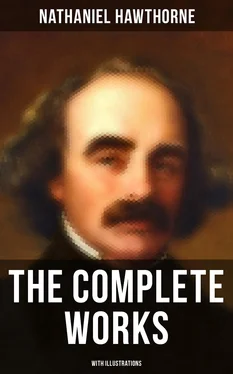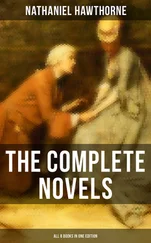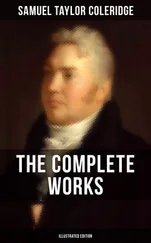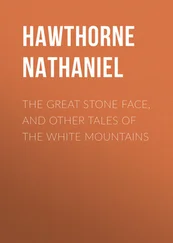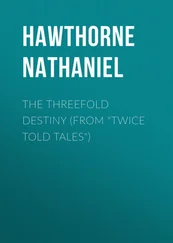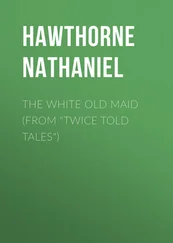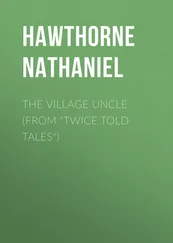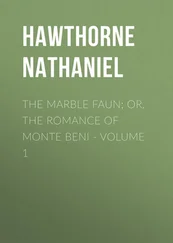“Hark!” cried Donatello, stopping short, as he was about to bind Miriam’s fair hands with flowers, and lead her along in triumph, “there is music somewhere in the grove!”
“It is your kinsman, Pan, most likely,” said Miriam, “playing on his pipe. Let us go seek him, and make him puff out his rough cheeks and pipe his merriest air! Come; the strain of music will guide us onward like a gayly colored thread of silk.”
“Or like a chain of flowers,” responded Donatello, drawing her along by that which he had twined. “This way! — Come!”
CHAPTER X
THE SYLVAN DANCE
Table of Contents
As the music came fresher on their ears, they danced to its cadence, extemporizing new steps and attitudes. Each varying movement had a grace which might have been worth putting into marble, for the long delight of days to come, but vanished with the movement that gave it birth, and was effaced from memory by another. In Miriam’s motion, freely as she flung herself into the frolic of the hour, there was still an artful beauty; in Donatello’s, there was a charm of indescribable grotesqueness hand in hand with grace; sweet, bewitching, most provocative of laughter, and yet akin to pathos, so deeply did it touch the heart. This was the ultimate peculiarity, the final touch, distinguishing between the sylvan creature and the beautiful companion at his side. Setting apart only this, Miriam resembled a Nymph, as much as Donatello did a Faun.
There were flitting moments, indeed, when she played the sylvan character as perfectly as he. Catching glimpses of her, then, you would have fancied that an oak had sundered its rough bark to let her dance freely forth, endowed with the same spirit in her human form as that which rustles in the leaves; or that she had emerged through the pebbly bottom of a fountain, a water-nymph, to play and sparkle in the sunshine, flinging a quivering light around her, and suddenly disappearing in a shower of rainbow drops.
As the fountain sometimes subsides into its basin, so in Miriam there were symptoms that the frolic of her spirits would at last tire itself out.
“Ah! Donatello,” cried she, laughing, as she stopped to take a breath; “you have an unfair advantage over me! I am no true creature of the woods; while you are a real Faun, I do believe. When your curls shook just now, methought I had a peep at the pointed ears.”
Donatello snapped his fingers above his head, as fauns and satyrs taught us first to do, and seemed to radiate jollity out of his whole nimble person. Nevertheless, there was a kind of dim apprehension in his face, as if he dreaded that a moment’s pause might break the spell, and snatch away the sportive companion whom he had waited for through so many dreary months.
“Dance! dance!” cried he joyously. “If we take breath, we shall be as we were yesterday. There, now, is the music, just beyond this clump of trees. Dance, Miriam, dance!”
They had now reached an open, grassy glade (of which there are many in that artfully constructed wilderness), set round with stone seats, on which the aged moss had kindly essayed to spread itself instead of cushions. On one of the stone benches sat the musicians, whose strains had enticed our wild couple thitherward. They proved to be a vagrant band, such as Rome, and all Italy, abounds with; comprising a harp, a flute, and a violin, which, though greatly the worse for wear, the performers had skill enough to provoke and modulate into tolerable harmony. It chanced to be a feast-day; and, instead of playing in the sun-scorched piazzas of the city, or beneath the windows of some unresponsive palace, they had bethought themselves to try the echoes of these woods; for, on the festas of the Church, Rome scatters its merrymakers all abroad, ripe for the dance or any other pastime.
As Miriam and Donatello emerged from among the trees, the musicians scraped, tinkled, or blew, each according to his various kind of instrument, more inspiringly than ever. A darkchecked little girl, with bright black eyes, stood by, shaking a tambourine set round with tinkling bells, and thumping it on its parchment head. Without interrupting his brisk, though measured movement, Donatello snatched away this unmelodious contrivance, and, flourishing it above his head, produced music of indescribable potency, still dancing with frisky step, and striking the tambourine, and ringing its little bells, all in one jovial act.
It might be that there was magic in the sound, or contagion, at least, in the spirit which had got possession of Miriam and himself, for very soon a number of festal people were drawn to the spot, and struck into the dance, singly or in pairs, as if they were all gone mad with jollity. Among them were some of the plebeian damsels whom we meet bareheaded in the Roman streets, with silver stilettos thrust through their glossy hair; the contadinas, too, from the Campagna and the villages, with their rich and picturesque costumes of scarlet and all bright hues, such as fairer maidens might not venture to put on. Then came the modern Roman from Trastevere, perchance, with his old cloak drawn about him like a toga, which anon, as his active motion heated him, he flung aside. Three French soldiers capered freely into the throng, in wide scarlet trousers, their short swords dangling at their sides; and three German artists in gray flaccid hats and flaunting beards; and one of the Pope’s Swiss guardsmen in the strange motley garb which Michael Angelo contrived for them. Two young English tourists (one of them a lord) took contadine partners and dashed in, as did also a shaggy man in goat-skin breeches, who looked like rustic Pan in person, and footed it as merrily as he. Besides the above there was a herdsman or two from the Campagna, and a few peasants in sky-blue jackets, and smallclothes tied with ribbons at the knees; haggard and sallow were these last, poor serfs, having little to eat and nothing but the malaria to breathe; but still they plucked up a momentary spirit and joined hands in Donatello’s dance.
Here, as it seemed, had the Golden Age come back again within the Precincts of this sunny glade, thawing mankind out of their cold formalities, releasing them from irksome restraint, mingling them together in such childlike gayety that new flowers (of which the old bosom of the earth is full) sprang up beneath their footsteps. The sole exception to the geniality of the moment, as we have understood, was seen in a countryman of our own, who sneered at the spectacle, and declined to compromise his dignity by making part of it.
The harper thrummed with rapid fingers; the violin player flashed his bow back and forth across the strings; the flautist poured his breath in quick puffs of jollity, while Donatello shook the tambourine above his head, and led the merry throng with unweariable steps. As they followed one another in a wild ring of mirth, it seemed the realization of one of those basreliefs where a dance of nymphs, satyrs, or bacchanals is twined around the circle of an antique vase; or it was like the sculptured scene on the front and sides of a sarcophagus, where, as often as any other device, a festive procession mocks the ashes and white bones that are treasured up within. You might take it for a marriage pageant; but after a while, if you look at these merrymakers, following them from end to end of the marble coffin, you doubt whether their gay movement is leading them to a happy close. A youth has suddenly fallen in the dance; a chariot is overturned and broken, flinging the charioteer headlong to the ground; a maiden seems to have grown faint or weary, and is drooping on the bosom of a friend. Always some tragic incident is shadowed forth or thrust sidelong into the spectacle; and when once it has caught your eye you can look no more at the festal portions of the scene, except with reference to this one slightly suggested doom and sorrow.
Читать дальше
